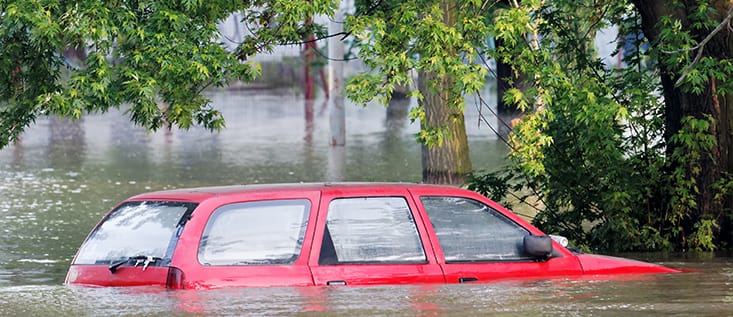We’ve all seen the devastating footage of submerged cars in flood waters both on TV and social media, but we never expect one of those cars to be ours.
You find your vehicle with a water line visible halfway up your car door, layers of mud lining the interior of your beloved possession. The undeniable stench of a swamp fills your nose, becoming more horrid every minute longer it sits in the sun. To top it all off, the insurance adjuster probably won’t be able to make it out for another few days. What do you do?
We have put together some important tips below for how to manage a flooded car.
The Day Of
DO NOT Start the Car
First and foremost do not attempt to start your car. Even if you are just wanting to see if the car still works, the turn of a key can lead to engine damage beyond repair. To ensure you don’t fry anything under the hood, it’s best to also disconnect the battery, but only if you know how.
Call your Insurance Company
If you haven’t already, call the insurance company and notify them of what has happened. Chances are they are going to be inundated with other flood damage claims, so this process could take some time. Check to see if you are covered for flood damage under your insurance policy and, if so, what the extent of your coverage is. If you have taken out comprehensive insurance it is likely you are already covered for water damage. You should also take photos of the damage to support your claim.
Evaluate Possible Damage
You could wait for the claims adjuster to come out, but mould and corrosion will begin to wreak havoc on the interior of your car in a matter of days. You should begin your assessment by determining how deep the car was submerged. If the water line on the car is sitting at the bottom of your doors, it is likely your car will work fine as the engine would not have been submerged. If there is a clear water line much higher on the door and/or the dashboard has been submerged, most insurance companies will consider the car totaled or written off, which means it is damaged beyond economically-reasonable repair.
Begin the Clean Up
The sooner you start and finish the clean up of your car the better – you will thank yourself in the long run! Begin by cleaning out as much of the water and mud as possible and drying the interior. You should dry the car by opening the doors, windows, the trunk and so forth, letting the sun and fresh air do most of the work. Recover any personal possessions and place towels on the floor and across seats to soak up excess water. It is likely that the carpets, mats, door panels and upholstery will need replacing.
The Day After
Visit your Mechanic
Similar to your insurance company, your local mechanic has probably been flooded with dozens of water damaged cars. There are a few simple tips and tricks to measure the damage of the car yourself, although if you are unfamiliar with what hides under the hood then you should definitely leave it to your trusted mechanic.
Check your fluids for any sign of water residue which may be present. Use the dipstick to check the oil; if any water droplets are evident on the stick you will need to change the oil and filter. Also, if the water was muddy, you will need to remove the oil pan and wash excess mud out.
Only if you have experience with engines, have completed all of the regular checks and are confident that the engine looks okay, you can try to start the car in order to examine the electrical systems (headlights, indicators, air conditioning, stereo, power locking, interior lights etc.). If anything looks or sounds amiss, it is likely that your car may be experiencing electrical trouble. Again, if you have never done anything like this before it is strongly recommended that you visit your mechanic.
Clean Out Around your Wheels and Tyres
If you are needing to move or tow your car, check and clean out around your wheels and tyres. Look for any debris which may have become lodged in and around the wheels, brakes, and underbody. Don’t forget to set the parking brake before crawling in and around your car!
The Following Week
If your insurance company labels your car as a ‘borderline case’, you should consider seeking total loss. Replacing your car will cost you a great deal of money but in the long run you will be saving yourself ongoing expenses to manage a damaged vehicle.
You should start to look into buying a car as a replacement. You need to be aware of other cars in the area that may have been water damaged. A great way to ensure you’re not purchasing a flood-damaged vehicle is to have a car broker search for the right vehicle for you. The broker will ensure the vehicle is mechanically sound and can organise for a mechanic to verify this.
Dealing with the aftermath of a flood-damaged car can be stressful and tiring. Following the steps above will minimise the complications associated with the car and help you to move on as simple and stress free as possible. If you are in the market to purchase a new car due to flood damage, the Car Search Brokers team will be more than happy to help you out. Alternatively, if your car has suffered from flood-damage and you are looking to sell your car, they can assist you with that process too. If you have any questions, contact Car Search Brokers today on 1300 650 890!
